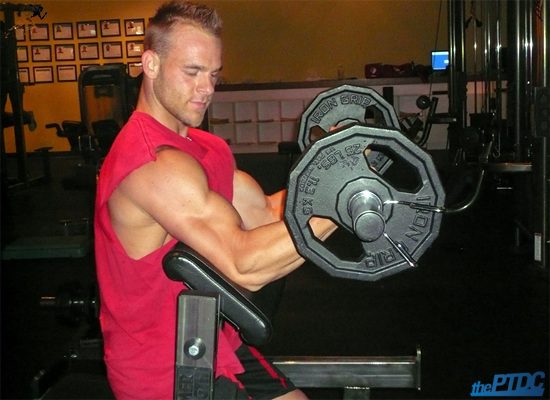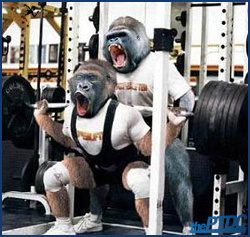The following article was originally published on strengthsensei.com. It is repurposed here with permission from Charles R. Poliquin.
It seems only natural that the concept of eccentric weight training has become associated with a man considered one of the most eccentric in bodybuilding, Arthur Jones.
The marketing genius behind Nautilus and MedX, Jones is a master showman, the caliber of P.T. Barnum.
But no one is born eccentric. Jones was given the label only after he became one of the most wealthy and influential men in the fitness business. And just as you must achieve a high level of accomplishment to be labeled eccentric, you must also achieve a high level of base strength to use eccentric training.
What Is Eccentric Training?
Eccentric training is an advanced training method, and, like Jones, it must be regarded as being on the fringe of what is considered normal.
Although Jones helped popularize eccentric training in this country, as in the case of the variable resistance cam, he did not invent it. In European strength-training textbooks, precise eccentric training protocols abound. Sylvain Bouchard, a speed skater I coached who set two World records, did as much as 50% of his workload with eccentric training to improve his starting speed.
When scientists discuss eccentric strength, they are referring to the amount of force produced when a muscle lengthens as opposed to concentric strength, which is the amount of force produced when a muscle shortens.

Eccentric refers to the amount of force produced when a muscle shortens so, in this case, it's when the bar descends.
Since fewer motor units are involved during an eccentric contraction (because of the passive resistance offered by the cross bridges), there is more mechanical load per motor unit in an eccentric contraction. As a result, eccentric training can generate up to 1.3 times more tension than concentric training. Greater tension provides increased stimulus to the muscle fibers, which in turn encourages greater biological adaptations. In fact, the late Norwegian strength expert Per Egil (Pella) Refsnes told me that eccentric training is the single best method to boost strength levels in elite strength athletes.
The Benefits and Advantages of Eccentric Training
Eccentric training builds mass and lots of it! Many studies have confirmed it is the lowering of weights, not the lifting, that is responsible for the hypertrophic response.
Eccentric training can improve power because it favorably alters force/ time characteristics. Finnish and Norwegian sport scientists have demonstrated that eccentric training stimuli can be used periodically to improve or maintain the neuromuscular system's ability to generate fast force production.
One protocol the Norwegians commonly use for the bench press is to have the athlete bench twice a week, once with eccentric-only contractions. For the first workout, the athlete would perform 5 sets of 4-6 reps at 80%-85% of their current maximum in the normal fashion, and for the second workout, the athlete would perform 120% of maximum with eccentric-only contractions.
Eccentric strength is specific to many sport activities. For example, during the follow through of a baseball pitch, the involved muscle groups must provide important decelerative contractions to preserve healthy arthrokinematics (joint functioning).
Eccentric strength is also important in sports that require exceptional jumping ability. Figure skaters often have the concentric strength to jump high enough to complete a complex jump like the double axle but do not have enough eccentric strength to control the landing. I tell skaters that if their lower body muscles are not strong enough to absorb the stress of landing, their joints will have to take it, and this will increase their risk of injury.
Eccentric strength can also improve exercise technique. When performing strength training exercises that contain a stretch-shortening cycle such as the squat and the bench press, technique is critical.

American studies on elite powerlifters demonstrated that the athletes who could lift the heaviest weights were the ones who could lower their weights more slowly. This implies that the inclusion of eccentric training may facilitate the process of lowering the resistance slowly under technical control. It also implies that an isokinetic exercise would have less specificity to an elite bench presser's technique because there is no eccentric component.
Some Disadvantages of Eccentric Training
Even though eccentric training shows great potential for strength improvement, it nonetheless has a few disadvantages. It often requires the help of training partners. Eccentric training can therefore be hazardous with certain exercises if the spotters are not properly trained or are not attentive-especially with squats.
With a little bit of imagination, you can often find a solution to lift the weight in the concentric range-one that is heavier than you could normally handle-without the assistance of spotters. For eccentric reverse curls, the resistance can be power cleaned for the concentric range and then lowered in a strict, eccentric fashion. There is also specially designed equipment that provides greater resistance in the eccentric range than in the concentric range, such as eccentric hooks or the X-Force machines
Another problem with eccentric training is that the intensity of this type of work is often underestimated. I saw an article in a bodybuilding magazine in which the author said eccentric-only workouts should be performed no more than three times a week for one month. Considering it takes seven to ten days to completely recover from an eccentric workout, such a protocol could result in overtraining and overuse injuries.
Also, athletes should only begin eccentric work after achieving a solid base in strength training. Embarking too early on an eccentric program could damage connective tissue and place the athlete at a high risk of muscle injury.
Practical Applications of Eccentric Training
Strength coaches recommend using anywhere from 100% to 175% of maximum for optimal loading in eccentric work. What should dictate how much weight to use in eccentric work is tempo; you should have a preset time of lowering (i.e., six seconds) in your mind before doing your set.
Muscle failure in a properly performed eccentric exercise is associated with a tetanus-like response where muscles are shaking involuntarily as they do their decelerating work.
The German word for eccentric is nachgeben, which means "yielding or overcoming." Keeping that concept in mind, as muscle and CNS fatigue sets in, you will have to concentrate on decelerating the load.
Athletes should try to visualize their muscles as giant brake systems that decelerate the resistance. If you start lowering the weight faster than the preset time, it's time to terminate the set. And the greater the range of motion in the exercise, the longer the preset lowering time.
Because, in the sporting world, slow eccentric training is at times associated with a diminution in the rate of force development, it should be used mainly in the preparatory period. Fast eccentric training (plyometrics) should be reserved for the competitive period.
Outside of slow lowering of supramaximal loads, there are many other ways to perform or combine various forms of eccentric training. Many bodybuilders would envy the musculature of elite rowers and bobsledders. One of the methods these athletes use to achieve such hypertrophy is the combination of lifting maximal loads ( 1-5 RM) and fast eccentric training (plyometrics).
This would involve alternating four to six sets of three to five reps of maximal weight with four to six sets of six jumps over hurdles. The rationale is that the heavy sets tap into the high threshold motor units, and the plyometrics create fiber damage that leads to the positive adaptation or hypertrophy of the high threshold fast-twitch Type IIb fibers.
I believe there should be a continuous, progressive build-up of eccentric training. To help get you started with eccentric training, here are six levels of eccentric training protocols, gradually progressing in difficulty.

In lieu of specialized equipment, a partner is often necessary.
Six Levels of Eccentric Training Protocols for Different Level Clients
Level 1
This level is for the athlete with less than two years training experience. No training with eccentric loads is needed; the simple lowering of loads under control should suffice.
Level 2
Use 70% of maximal load (1RM); go to concentric muscle failure; then do 2 to 3 forced repetitions with the same load. Repeat for two to three sets. As a variation, you could perform only one forced rep, but try to stop the descending weights three times for a count of four seconds.
Level 3
Use 70% of maximal load; go to concentric muscle failure; then do 2 or 3 forced repetitions with 15% more weight. Repeat for two or three sets.
Level 4
Use 80% of maximal load; go to concentric muscle failure, and then do 2-3 forced repetitions with 20% more weight. Repeat for three to four sets. As an alternative for Levels 3 and 4, a training partner can manually apply resistance (i.e., push down on the bar) for the eccentric portion instead of adding weight.
These additional negative repetitions will exhaust eccentric strength levels after you achieve concentric muscular failure.
Level 5
Using 110%-120% of maximal load, do 4-6 eccentric-only reps for 4-6 sets, resting 4-5 minutes between sets. Take eight to ten seconds to lower the weight each set.
Level 6
Using 125%-140% of maximal load, do 2-3 eccentric-only reps for 5-6 sets, resting 4-5 minutes between sets. Take four to six seconds to lower the weight each set.
Although it would be easy to prescribe a single exercise tempo such as "it should take twice as long to lower the weight as it does to raise it," such advice will not work for advanced athletes, at least not for very long. Eccentric training, used wisely, is a powerful tool that will take you to the way of serious progress.










